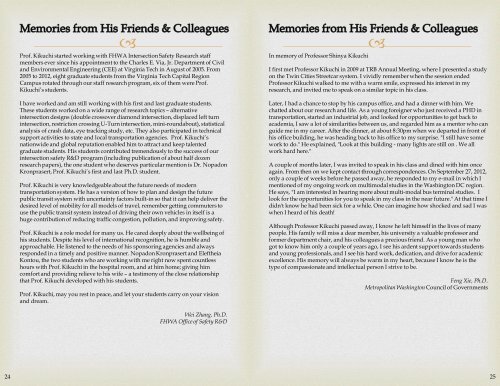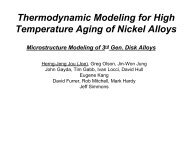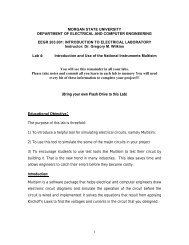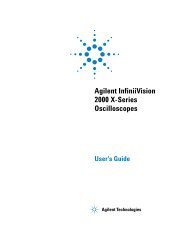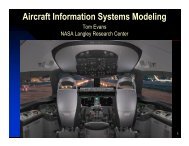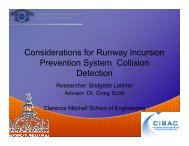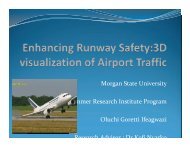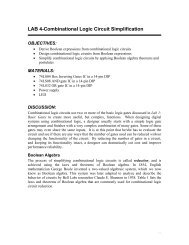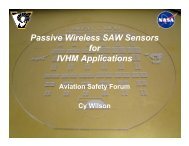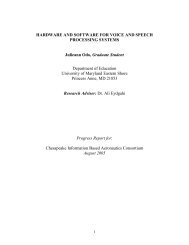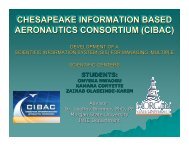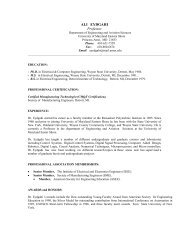In Loving Memory of - Morgan State University
In Loving Memory of - Morgan State University
In Loving Memory of - Morgan State University
- No tags were found...
Create successful ePaper yourself
Turn your PDF publications into a flip-book with our unique Google optimized e-Paper software.
Pr<strong>of</strong>. Kikuchi started working with FHWA <strong>In</strong>tersection Safety Research staffmembers ever since his appointment to the Charles E. Via, Jr. Department <strong>of</strong> Civiland Environmental Engineering (CEE) at Virginia Tech in August <strong>of</strong> 2005. From2005 to 2012, eight graduate students from the Virginia Tech Capital RegionCampus rotated through our staff research program, six <strong>of</strong> them were Pr<strong>of</strong>.Kikuchi’s students.I have worked and am still working with his first and last graduate students.These students worked on a wide range <strong>of</strong> research topics – alternativeintersection designs (double crossover diamond intersection, displaced left turnintersection, restriction crossing U-Turn intersection, mini-roundabout), statisticalanalysis <strong>of</strong> crash data, eye tracking study, etc. They also participated in technicalsupport activities to state and local transportation agencies. Pr<strong>of</strong>. Kikuchi’snationwide and global reputation enabled him to attract and keep talentedgraduate students. His students contributed tremendously to the success <strong>of</strong> ourintersection safety R&D program (including publication <strong>of</strong> about half dozenresearch papers), the one student who deserves particular mention is Dr. NopadonKronprasert, Pr<strong>of</strong>. Kikuchi’s first and last Ph.D. student.Pr<strong>of</strong>. Kikuchi is very knowledgeable about the future needs <strong>of</strong> moderntransportation system. He has a version <strong>of</strong> how to plan and design the futurepublic transit system with uncertainty factors built-in so that it can help deliver thedesired level <strong>of</strong> mobility for all models <strong>of</strong> travel, remember getting commuters touse the public transit system instead <strong>of</strong> driving their own vehicles in itself is ahuge contribution <strong>of</strong> reducing traffic congestion, pollution, and improving safety.Pr<strong>of</strong>. Kikuchi is a role model for many us. He cared deeply about the wellbeing <strong>of</strong>his students. Despite his level <strong>of</strong> international recognition, he is humble andapproachable. He listened to the needs <strong>of</strong> his sponsoring agencies and alwaysresponded in a timely and positive manner. Nopadon Kronprasert and EleftheiaKontou, the two students who are working with me right now spent countlesshours with Pr<strong>of</strong>. Kikuchi in the hospital room, and at him home; giving himcomfort and providing relieve to his wife – a testimony <strong>of</strong> the close relationshipthat Pr<strong>of</strong>. Kikuchi developed with his students.Pr<strong>of</strong>. Kikuchi, may you rest in peace, and let your students carry on your visionand dream.<strong>In</strong> memory <strong>of</strong> Pr<strong>of</strong>essor Shinya KikuchiI first met Pr<strong>of</strong>essor Kikuchi in 2009 at TRB Annual Meeting, where I presented a studyon the Twin Cities Streetcar system. I vividly remember when the session endedPr<strong>of</strong>essor Kikuchi walked to me with a warm smile, expressed his interest in myresearch, and invited me to speak on a similar topic in his class.Later, I had a chance to stop by his campus <strong>of</strong>fice, and had a dinner with him. Wechatted about our research and life. As a young foreigner who just received a PHD intransportation, started an industrial job, and looked for opportunities to get back toacademia, I saw a lot <strong>of</strong> similarities between us, and regarded him as a mentor who canguide me in my career. After the dinner, at about 8:30pm when we departed in front <strong>of</strong>his <strong>of</strong>fice building, he was heading back to his <strong>of</strong>fice to my surprise. "I still have somework to do." He explained, "Look at this building - many lights are still on . We allwork hard here."A couple <strong>of</strong> months later, I was invited to speak in his class and dined with him onceagain. From then on we kept contact through correspondences. On September 27, 2012,only a couple <strong>of</strong> weeks before he passed away, he responded to my e-mail in which Imentioned <strong>of</strong> my ongoing work on multimodal studies in the Washington DC region.He says, "I am interested in hearing more about multi-modal bus terminal studies. Ilook for the opportunities for you to speak in my class in the near future." At that time Ididn't know he had been sick for a while. One can imagine how shocked and sad I waswhen I heard <strong>of</strong> his death!Although Pr<strong>of</strong>essor Kikuchi passed away, I know he left himself in the lives <strong>of</strong> manypeople. His family will miss a dear member, his university a valuable pr<strong>of</strong>essor andformer department chair, and his colleagues a precious friend. As a young man whogot to know him only a couple <strong>of</strong> years ago, I see his ardent support towards studentsand young pr<strong>of</strong>essionals, and I see his hard work, dedication, and drive for academicexcellence. His memory will always be warm in my heart, because I know he is thetype <strong>of</strong> compassionate and intellectual person I strive to be.Feng Xie, Ph.D.Metropolitan Washington Council <strong>of</strong> GovernmentsWei Zhang, Ph.D.FHWA Office <strong>of</strong> Safety R&D2425


